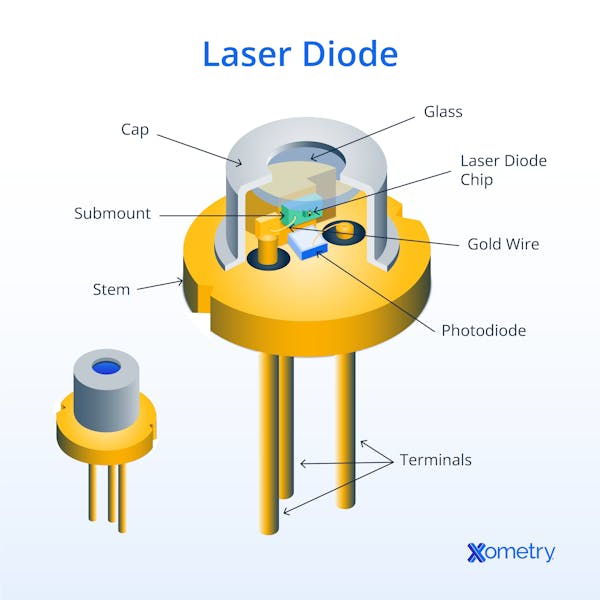A laser diode (or diode laser) is a semiconductor device that undergoes stimulating emission to emit coherent light. Laser diodes offer high power for their size and produce electrical-power-efficient laser radiation. They consist of a p-n semiconductor junction, with a forward bias voltage applied to trigger a current through the junction. This induces population inversion (of electrons in the excited state) in the semiconductor material, biasing towards high-energy states. These results stimulate the emission of narrow-band coherent photons, with the frequency primarily determined by the semiconductor's bandgap energy. Laser diodes are widely used across various industries, including telecommunications, material processing, and medical treatments.
This article will discuss diode lasers, how they work, their applications, and their types.
What Is a Diode Laser?
Diode lasers are compact, solid-state devices that generate coherent light from semiconductor material. They are constructed using materials like gallium arsenide (GaAs) or gallium nitride (GaN). They operate by applying an electrical current to the semiconductor material, which stimulates the emission of coherent photons. Diode lasers are compact, making them ideal for portable applications. They can be designed to emit light across a wide range of wavelengths from ultraviolet (UV) to near-infrared (NIR) and mid-infrared (MIR). They can operate as continuous waves (CW) or pulsed emitters. Diode lasers are used in diverse sectors such as telecommunications, data storage, barcode scanners, hair removal, medical/cosmetic treatments, displays, research tools, and manufacturing.

What Is the Origin of Diode Lasers?
The first diode lasers were developed in the early 1960s. The most significant steps were made by Robert N. Hall (General Electric, G.E.), who developed gallium arsenide (GaAs) IR laser diodes. Nick Holonyak Jr. (also G.E.) developed gallium arsenide phosphide (GaAsP) devices, emitting visible light, also in 1962. Zhores I. Alferov developed heterostructure lasers with multiple semiconductor junctions in the 1970s in the Soviet Union. This improved the efficiency and performance of diode lasers, making them more practical and usable.
How Does a Diode Laser Work?
Diode lasers work by stimulating the emission of photons at a semiconductor junction. The semiconductor material has specific energy band gaps that trigger the generation and amplification of coherent light. A diode consists of a p-n junction. The n-type region creates an excess of negatively charged carriers (electrons) while the p-type creates an excess of positively charged carriers (holes). The junction forms a depletion region between the two materials. When a forward bias voltage (positive to the p and negative to the n material) is applied across the junction, current flows. This causes charge carriers to move across the junction. Electrons from the n region and holes from the p region are injected into the depletion region. These meet and recombine, initially releasing spontaneous photons, but lasing occurs when these photons trigger further identical emissions through stimulated emission.
The diode laser is designed with reflective surfaces at the ends, forming an “optical cavity.” The photons reflect internally, and optical feedback enhances the stimulated emissions and results in narrow-band, coherent light. Stimulating emission also occurs when a photon interacts with an excited electron, causing it to emit another photon. These additional photons are identical to the triggering photon, leading to amplification. As the stimulated emission continues and photons are reflected within the cavity, the intensity of the laser energy increases.
What Is the Importance of a Diode Laser?
Diode lasers are valued because of the following:
- They are compact for their power levels. This makes them easy to integrate into smaller systems.
- Applications benefit from higher power efficiency than alternative laser types, as they convert electricity into laser power with low wastage.
- Design choices offer wavelength flexibility. Diode lasers can emit light from the ultraviolet (UV), through visible to near-infrared (NIR) regions. Wavelength selectability makes the class ideal for many applications.
- They offer high-speed operation and precise control over the laser power. Rapid response and precise beam focusing enable highly effective energy for cutting, engraving, and drilling.
- Diode lasers achieve long and reliable operational life. This makes them suitable for long, continuous operation.
- The accelerating development has improved power output, efficiency, beam quality, and reliability.
What Is the Primary Use of Diode Lasers?
Diode lasers serve diverse roles across industries, including:
- Infrared diode lasers are essential for fiber-optic communications, supporting high-speed data transfer by enabling high-frequency signal transmission.
- Laser diodes are key to many printing applications, with high beam quality allowing very high resolution of the printed image.
- In medicine and cosmetics, diode lasers are used for hair removal, skin treatments, tattoo removal, vascular therapies, and dental procedures, providing targeted energy that minimizes damage to nearby tissue.
- In manufacturing, they enable high-speed cutting, welding, marking, and surface processing with precision and repeatability.
- In research, diode lasers support spectroscopy, microscopy, and material analysis, helping identify molecular and chemical properties.
- In consumer electronics, diode lasers power devices like laser pointers, barcode scanners, and optical drives, benefiting from their small size and low power needs.
- Diode lasers also enable sensing technologies like distance measurement, lidar, and 3D scanning, supporting precision tasks in metrology and industrial inspection.
What Are the Different Types of Diode Lasers?
Several types of diode lasers are available, each optimized for different applications:
- Edge-emitting or Fabry-Perot lasers are the most common type, emitting light along the plane of the semiconductor junction.
- VCSELs (Vertical-Cavity Surface-Emitting Lasers) emit light vertically from the wafer surface, using Bragg reflectors to enhance output efficiency.
- Quantum Cascade Lasers (QCLs) operate using intersubband transitions in quantum wells, producing tunable mid- and far-infrared light by adjusting bias conditions.
- Distributed feedback (DFB) lasers use internal gratings for wavelength stability, producing narrow-line, single-mode emission ideal for telecom and sensing.
- External cavity diode lasers (ECDLs) combine a diode chip with an external cavity for tunable, narrow-linewidth output, ideal for spectroscopy and precision measurements.
- Superluminescent Diodes (SLDs) provide broadband, low-coherence light, useful in imaging and optical coherence tomography (OCT).
What Are the Main Applications of Diode Lasers?
Diode lasers have many applications, including those listed below:
1. Medical
Due to their compactness, durability, and flexibility, diode lasers are widely used in medicine for procedures such as hair removal, skin resurfacing, soft tissue surgery, photodynamic therapy (PDT), and endovenous laser treatment (EVLT). In low-level laser therapy (LLLT), diode lasers stimulate cellular metabolism, reduce inflammation, and aid in pain relief and tissue repair.
2. Printing
Laser diodes are central to many printing technologies, serving as the light source in laser printers where the beam scans a photoreceptive surface to form an electrostatic image. They’re also used in barcode and QR printers, where they heat thermally sensitive paper to create codes. Laser diodes are also used in laser marking, engraving, and in security printing, such as adding covert features to passports, banknotes, and official documents.
3. Telecommunications
In fiber-optic systems, diode lasers serve as the light source for data transmission. In long-distance fiber-optic links, signal amplification is necessary to overcome signal degradation. Erbium-doped fiber amplifiers (EDFAs) are used for this purpose. In optical time-domain reflectometry (OTDR)—a fiber-optic testing method—a laser emits short pulses of light into the fiber, and the reflected (backscattered) light is analyzed to determine fiber loss and locate fiber breaks or kinks. They are also used in free-space optical communication and in wavelength division multiplexing (WDM), enabling multiple signals to share the same fiber by using different wavelengths.
4. Spectroscopy
Laser diodes are well-suited for spectroscopy, offering precise and sensitive material analysis. In Raman spectroscopy, laser light is directed onto a sample, and the scattered light is analyzed to reveal the material’s composition and structure. Their tunability allows selective excitation at specific Raman shifts. They also serve as excitation sources in fluorescence spectroscopy, enabling substance identification through emitted light measurement. Their monochromatic output ensures precise excitation. Other methods include diode laser absorption spectroscopy (DLAS/TDLAS), cavity ring-down spectroscopy (CRDS), laser-induced breakdown spectroscopy (LIBS), and laser-induced fluorescence (LIF).
5. Sensing
Laser diodes are widely used in sensing because their coherent light enables detection of changes in reflected or transmitted signals. Laser diodes are used in distance and position measurement, particularly in laser triangulation sensors, which project beams to determine target position. These are common in robotics, automation, and metrology. Other uses include LiDAR, laser Doppler velocimetry (LDV), and flow or level sensing.
6. Materials Processing
Laser diodes are widely used in materials processing thanks to their compact size, high power, and energy efficiency. High-power diode lasers are used in industrial cutting systems for metals, plastics, and composites. When properly focused, diode lasers deliver high energy density, allowing for efficient cutting of thin materials. They are also used in welding, where the beam melts and fuses materials. Laser welding is increasingly important in the automotive, jewelry, and electronics sectors.
Diode lasers are used for fine drilling and micromachining of polymers and thin materials, though other laser types are preferred for metals and ceramics. Laser micromachining is used to shape or ablate materials with high precision, such as in MEMS production.
How To Use a Diode Laser?
Laser diodes serve a wide range of roles and are commonly integrated into systems for:
- Handheld medical devices are used for skin treatments, cutting, hair removal, vein closure, and imaging applications.
- Industrial tools for material cutting, welding, cleaning, and drilling.
- Optical data transmission in fiber-optic networks, and in some specialized free-space optical communication systems.
- Sensing systems for distance, speed, and material property measurements.
How Is the Wavelength of a Diode Laser Determined?
The semiconductor material’s bandgap energy primarily determines a diode laser’s wavelength, making it highly tunable across different ranges. Some examples are listed below:
- Different semiconductor materials define specific wavelength ranges. For example, GaAs produces infrared light, while GaN is used for blue and ultraviolet lasers.
- The bandgap energy sets the photon energy released during electron transitions. The relationship follows the equation λ = c / Eg, where λ is the wavelength, c is the speed of light, and Eg is the bandgap energy.
- Quantum wells and quantum dots further tune the emission spectrum by modifying the bandgap through spatial confinement.
- Temperature changes can shift the bandgap energy, affecting the emitted wavelength.
What Is the Typical Output Power of a Diode Laser?
Laser diode output power varies widely, depending on the application and design. Factors such as laser design, semiconductor material properties, and cooling influence the achievable output power. Output ranges from microwatts to tens of kilowatts, covering low to high-power applications. Low-power diode lasers (up to tens of milliwatts) are used in laser pointers, barcode scanners, optical drives, and biomedical sensors. Medium-power devices (10 mW to 30 W) are common in laser printers, projectors, and fiber-optic systems. High-power diode lasers (30 W to several kilowatts) are used in industrial, medical, and scientific applications, though higher power levels are typically achieved with other laser types.
What Are the Best Practices for Aligning a Diode Laser?
Aligning a diode laser requires care to ensure efficient operation. Some best practices are listed below:
- Mounting stability, both of the laser and the system, is critical for consistent performance.
- Begin by roughly aligning the diode laser and the optical components along the desired optical path. Use alignment tools such as beam dumps, beam profilers, or alignment targets.
- Perform coarse alignment by adjusting the position and angle of the laser source and optical components. Follow the alignment procedure recommended by the equipment supplier/maker.
- Use beam profilers or viewers to observe the beam shape and optimize alignment.
- Power monitoring with a photodiode monitors the output power of the laser, allowing you to assess the effect of alignment adjustments on the beam quality.
- Small iterative adjustments enable fine-tuning. Perform micro changes to the position, tilt, and rotation of the optical components while monitoring the beam profile and power output.
Proper thermal management is essential, as diode lasers are highly sensitive to temperature, which can affect wavelength and power stability.
How Can Diode Lasers Be Applied in Laser Welding?
Diode lasers are widely used in laser welding applications due to their high power, compact size, durability, and efficiency. Their high power efficiency, compact size, and precise control make them ideal for automated welding systems. Select the device based on output power, beam quality, wavelength, and pulse duration to suit the requirements. The beam delivery system guides the laser beam from the diode source to the weld. This consists of focusing and beam-shaping optics and protective covers. Focusing the beam to the correct spot size and position maximizes energy density at the weld zone, enabling effective melting and bonding. Key parameters such as power, pulse duration, and feed speed must be optimized for joint quality. Optimizing these for joint design, material type, and material thickness is critical for weld quality.
Start by forming a melt pool and move steadily along the joint to maintain fusion consistency. A consistent gap and alignment between the workpieces ensures uniform and sufficient/consistent penetration.
How Are Diode Lasers Used in Laser Cutting?
High-power diode lasers are increasingly used in laser cutting applications, especially for thin metals, plastics, and organics, due to their electrical efficiency and compact integration. Select a diode laser based on output power, beam quality, and wavelength, ensuring it matches the material and thickness requirements. Prepare the workpiece to be cut by cleaning and positioning it in the desired configuration. Beam delivery uses focusing optics to direct energy precisely to the cut zone while protecting the optics from debris.
Focusing the beam to achieve the required/recommended spot and kerf properties will improve the cut rate and quality and minimize the heat-affected zone. Cutting parameters such as power, focus position, gas assist, and feed speed should be optimized to balance cutting speed, edge quality, and thermal effects. These parameters are adjusted to achieve a clean cut, minimal HAZ, and high throughput. For more information, see our guide on what a laser cutter is.
Are UV Diode Lasers Used in Laser Cutting?
No, UV diode lasers are not typically used for cutting but are ideal for micro-ablation, surface structuring, and delicate material processing. Because UV light is highly absorbed at the surface, it causes shallow ablation with minimal penetration, making it unsuitable for through-cutting thicker materials. While UV lasers are extensively used in micromachining, lithography, semiconductor processing, and medical applications, they are not suitable for cutting through thicker materials or for high-speed cutting applications.
How Much Does a Diode Laser Machine Cost?
The price of laser diode machines hinges on power requirements, required frequency of emission, and optical quality issues. Compact low-power diode laser modules (up to a few watts) typically range from under $100 to several thousand dollars, depending on quality, wavelength, and application. Higher-power modules (tens of watts and above) can start in the low thousands and scale significantly with power and integration. Complete industrial laser systems for cutting, welding, or surface processing can cost tens of thousands to several hundred thousand dollars, depending on power, integration, and automation features.
It should be noted that the cost of a diode laser machine is only partially determined by the cost of the laser itself. The rest of the machine typically represents the largest portion of the overall system cost.
What Is the Lifespan of a Diode Laser Machine?
The lifespan of a diode laser is influenced by the quality of the diode materials, manufacturing processes, intensity of use, overheating influences, and operating conditions. Diode lasers typically offer operational lifespans ranging from 10,000 to over 50,000 hours, depending on design, operating conditions, and cooling.
What Are the Safety Considerations When Using Diode Lasers?
When using diode-laser-based equipment, accepted basic safety precautions must be adhered to, including:
- Understand the safety measures and precautions associated with the laser classification of your equipment.
- Use the right laser safety goggles or eyewear for the laser wavelength of your equipment. Ensure that all personnel within the laser-controlled area wear wavelength-specific protective eyewear.
- Diode-laser-equipped machines must have interlock mechanisms to prevent accidental exposure to the beam.
- Display appropriate laser safety signage for the class of equipment.
- High-power devices (typically above Class 3B or 500 mW) require a controlled area. Restrict access.
- Provide appropriate operational safety training for staff working with or around the machine.
- Make sure that the beam is enclosed, to prevent exposure. Use beam blocks or beam dumps to terminate the beam without flash or reflection.
- Be aware of potential fire hazards, as with any hot process. Ensure fire extinguishers are on hand.
- Regularly inspect and maintain the equipment and environs to manage risks.
- Set up emergency procedures in case of accidents. This includes protocols for laser injuries, reporting incidents, and seeking medical attention.
How Does Temperature Affect the Performance of a Diode Laser?
Temperature can significantly affect the performance of a diode laser. Output power and efficiency are affected by temperature. As temperature rises, the diode's threshold current increases and efficiency decreases, often reducing output power if current is not increased to compensate. Wavelength increases (redshifts) with rising temperature due to bandgap narrowing. Higher-precision devices incorporate thermoelectric (Peltier) coolers to improve stability. Temperature rise can degrade beam quality by increasing divergence, spectral width, and reducing coherence. This is a result of refractive index changes within the semiconductors.
What Are the Advantages of Diode Lasers?
Diode lasers integrate a range of advantages over other laser systems that make them a good choice in many applications. These are listed below:
- Their excellent power-to-weight/size ratio and limited need for ancillary equipment make them easy to integrate into equipment.
- Diode lasers offer higher electrical-to-optical conversion efficiency compared to most other laser types, minimizing energy loss.
- They are electrically pumped, not requiring additional optics and external laser pumps.
- They can operate in continuous wave (CW) or pulsed mode, increasing their application flexibility.
- These devices can be constructed in a wide range of emission wavelengths, from ultraviolet (UV) to infrared (IR).
- They offer fast modulation capabilities, including direct intensity and pulse width control, enabling high-speed applications.
- They generally have much longer operational lifetimes and require less maintenance than most alternatives when correctly operated.
- They are fast to start and shut down, allowing for greater system availability.
- They are a class of devices with wide-ranging power outputs, allowing precise specifications for the application.
What Are the Disadvantages of Diode Lasers?
Laser diodes also have some severe disadvantages, including:
- Multi-mode diode lasers generally produce lower beam quality than single-mode lasers or traditional solid-state and gas lasers, limiting precision applications.
- Ultraviolet (UV) and deep infrared (IR) diode lasers can be difficult and expensive to make.
- Diode lasers are very sensitive to temperature fluctuations. Effective thermal management and temperature stabilization systems are required for stability.
- Diode lasers typically have lower power capabilities than fiber or CO2 lasers.
- Lifetime and reliability are shortened by bad operating conditions.
- High-performance or wavelength-specific diode lasers can be costly compared to standard laser technologies like CO₂ or fiber lasers.
- Beam divergence is greater than some comparable devices/systems, limiting the focusing ability.
Is a Diode Laser a Type of Semiconductor Laser?
Yes, diode lasers are the most common type of semiconductor laser, operating by stimulating photon emission through electrical excitation in a semiconductor junction.
What Is the Difference Between a Diode Laser and Other Types of Lasers?
Diode lasers are unique in most regards, particularly in their operating principles, construction, and operational properties. These differences include:
- The operational principle is population inversion within a solid semiconductor at a p-n junction. Gas lasers rely on population inversion in a gas.
- They are unique in generating laser light directly from a semiconductor material using electrical current, eliminating the need for bulky optical pumping systems.
- Most other laser devices require an optical pumping system from discharge, flash, or a low-power laser. Diode lasers use pure electrical pumping to initiate the light.
- Diode lasers offer the smallest package size per watt of output of any laser system.
- Because they are electrically pumped and generate minimal waste heat, diode lasers typically achieve higher electrical-to-optical efficiency than most other laser types.
- Diode lasers can be tuned to a wide spectrum of wavelengths and, in some cases, sweep a spectrum. Other laser systems emit more fixed wavelengths.
- They cannot (yet) achieve the extreme power of some other systems, although the pace of development remains rapid.
What Is the Difference Between a Single-Mode and Multi-Mode Diode Laser?
Single-mode and multi-mode refer to the number of light paths or spatial modes supported within a diode laser's waveguide or optical system.
- Single-mode diode lasers emit light in a well-defined and tightly confined path with a small diameter and low divergence, resulting in a narrow and focused beam. Multi-mode diode lasers emit light in multiple spatial modes with a larger beam diameter and higher divergence.
- Single-mode diode lasers provide better beam quality than multi-mode devices. The single-mode beam has a more uniform intensity profile, lower divergence, and better spatial coherence. This makes single-mode diode lasers suited to precise focusing, high spatial resolution, and longer propagation distances.
- Single-mode diode lasers are typically used with single-mode optical fibers, which have a small core size (typically around 9–10 micrometers). Multi-mode devices are typically connected to multi-mode fibers, which have a larger core size (e.g., 50 or 62.5 micrometers) to accommodate the wider beam.
- Single-mode diode lasers are better suited for high-precision applications and long-distance communication, suffering less dispersion and attenuation. Multi-mode diode lasers suffer from higher dispersion and attenuation effects due to the broader beam.
- Single-mode diode lasers are generally more expensive due to the tighter manufacturing tolerances required for high beam quality, but they are preferred for applications needing long-distance transmission or precision focusing.
What Is the Difference Between a Diode-Pumped Solid-State Laser and a Diode Laser?
A diode-pumped solid-state laser uses a diode to pump energy into a crystal or glass medium that produces the laser beam. In contrast, a diode laser generates the laser light directly from its semiconductor junction without needing a separate lasing medium. Most laser types require an optical energy source to initiate the laser beam, whereas diode lasers use direct electrical current as the initiator of the population inversion that generates laser light.
Summary
This article presented diode lasers, explained them, and discussed their various applications. To learn more about diode lasers, contact a Xometry representative.
Xometry provides a wide range of manufacturing capabilities, including laser cutting and other value-added services for all of your prototyping and production needs. Visit our website to learn more or to request a free, no-obligation quote.
Disclaimer
The content appearing on this webpage is for informational purposes only. Xometry makes no representation or warranty of any kind, be it expressed or implied, as to the accuracy, completeness, or validity of the information. Any performance parameters, geometric tolerances, specific design features, quality and types of materials, or processes should not be inferred to represent what will be delivered by third-party suppliers or manufacturers through Xometry’s network. Buyers seeking quotes for parts are responsible for defining the specific requirements for those parts. Please refer to our terms and conditions for more information.


